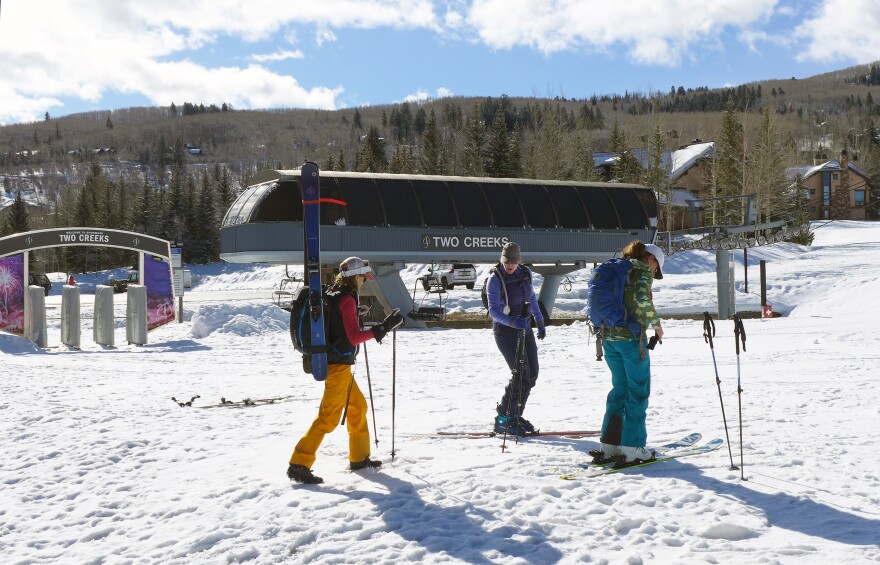Stay-at-home orders and closed businesses, combined with an abrupt end to the ski season, are changing the electricity consumption and demand patterns for Holy Cross Energy, which supplies electricity to much of the Roaring Fork and Eagle river valleys.
Since the ski lifts between Aspen and Vail stopped spinning on March 14, Holy Cross has seen demand for electricity fall 8% to 10%.
“It brought the onset of spring load patterns a month early,” said Steve Beuning, vice president of power supply and programs at Holy Cross.
Holy Cross supplies electricity to Aspen’s four mountains, as well as to Sunlight, Vail and Beaver Creek ski areas.
Ski resorts demand a lot of electricity in the winter, so it’s normal to see declines in demand and use in the spring. But that change is typically staggered as mountains close one at a time. The current drop was compounded by the fact that all resort business halted at once.
“Lifts are the big drop in electricity use from business being closed due to COVID-19,” Ryland French, Aspen Skiing Company’s energy manager, wrote in an email. “Buildings, hotels and restaurants are significant, too.”
In 2019, Holy Cross estimated that 41% of its power was supplied from renewable sources such as wind, solar and biomass. Fifty-one percent came from coal and 6% from gas.
While the COVID-19 lockdown in China has resulted in a drop in carbon emissions and NASA recently released satellite images that show significant declines in emissions of the air pollutant nitrogen dioxide over areas that have seen stay-at-home orders – such as China and California – climate activists warn that this silver lining is around a huge, dark cloud.
“Successful climate action will not come at the expense of the economy, like these COVID-19 emissions reductions have,” French wrote in an email. “The best plans for acting on climate will grow the economy and create jobs.”
Auden Schendler, Skico’s vice president for sustainability, said there are some climate change lessons in this moment. For years, Schendler has raised concern that climate change could mean the loss of early- and late-season skiing.
“If you lose the last couple weeks in March, you’re probably going to have viability problems as a business. And we just did that. We shaved off the last two weeks in March, and it’s a disaster, economically for the whole valley,” Schendler said. “In a sense, it’s a dry run for what one could expect in a drier world, midcentury.”
Schendler said Skico is now focusing on supporting workers who were laid off when the mountains closed, evaluating its own finances and helping the community response where appropriate.

While the early and sudden decrease in electricity demand from shutting down ski areas is the most discernible shift in the local energy picture, Holy Cross has also seen an increase in residential energy use as people work from home and shelter in place.
Electric use typically peaks in the evenings, but the March peak demand for Xcel Energy, a wholesale supplier to Holy Cross, has occurred at 1 p.m., something Beuning has never seen in his career.
Beuning said the shift to a 1 p.m. demand peak “doesn’t have an impact on reliability, and we’ll have sufficient energy production so that we won’t run out of electricity when the demand changes during the hour of the day. But it does impact our forecasts, and we use our forecasts to help manage our costs for electricity.”
Residential energy use has increased this month but not enough to offset reduced business and commercial electricity use.
Mona Newton, executive director of the Community Office for Resource Efficiency, or CORE, says she’s concerned that residents’ energy use – and utility bills – will increase as people spend more time at home.
“If you’re home more, you’re cooking more, showering more, cleaning more, doing more laundry, watching more TV, you’re using more plug load, and your utility bills are going to go up,” Newton said.
CORE is working to provide tips on how to reduce electricity use, including using smart power strips to improve efficiency and line-drying one’s laundry instead of using a dryer. Holy Cross representatives say the utility will not disconnect service for customers who can’t pay during the pandemic and is offering payment plans.
As the stay-at-home orders continue, Newton said she’s concerned that the decrease in electricity use could damage Holy Cross’ ongoing efforts to increase use of renewable energy.
“If you see a dramatic drop, it’s just like any business – they’re going to lose income,” Newton said. “They rely on revenues for operations and their goals,” including targets for renewable energy.
For now, even as demand and usage patterns change, Beuning said Holy Cross does not plan to raise rates, but the company is in uncharted territory.
“How that will play out over time, we don’t know,” Beuning said. “We only have five days, 10 days of experience with this altered consumption. But for now, no change is expected.”
Holy Cross does not expect to delay progress on a 35-acre, 5-megawatt solar farm between Aspen and Woody Creek, nor does it expect to postpone goals to provide 70% of its power from renewable sources by 2030.
Editor’s note: Aspen Journalism is a local nonprofit journalism organization. For more, go to aspenjournalism.org.



